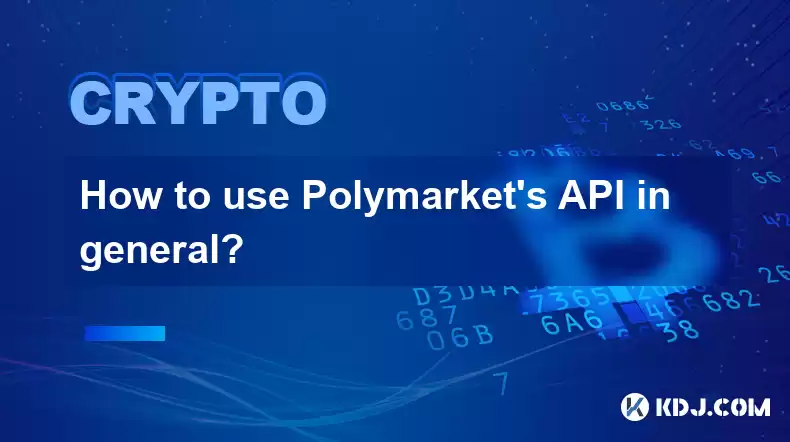-
 bitcoin
bitcoin $87959.907984 USD
1.34% -
 ethereum
ethereum $2920.497338 USD
3.04% -
 tether
tether $0.999775 USD
0.00% -
 xrp
xrp $2.237324 USD
8.12% -
 bnb
bnb $860.243768 USD
0.90% -
 solana
solana $138.089498 USD
5.43% -
 usd-coin
usd-coin $0.999807 USD
0.01% -
 tron
tron $0.272801 USD
-1.53% -
 dogecoin
dogecoin $0.150904 USD
2.96% -
 cardano
cardano $0.421635 USD
1.97% -
 hyperliquid
hyperliquid $32.152445 USD
2.23% -
 bitcoin-cash
bitcoin-cash $533.301069 USD
-1.94% -
 chainlink
chainlink $12.953417 USD
2.68% -
 unus-sed-leo
unus-sed-leo $9.535951 USD
0.73% -
 zcash
zcash $521.483386 USD
-2.87%
How to use Polymarket's API in general?
The Polymarket API allows developers to programmatically interact with the prediction market platform, enabling access to market data, bet placement, and the creation of custom prediction markets.
Feb 11, 2025 at 09:24 am

An in-depth Guide to the Polymarket API
Key Points:
- Introduction to the Polymarket API
- How to Create an Account
- How to Get an API Key
- How to Make API Calls
- How to Parse the Responses
- Advanced Features
Introduction to the Polymarket API
Polymarket is a prediction market platform that allows users to bet on the outcome of real-world events. The Polymarket API provides a programmatic interface to the platform, allowing developers to access market data, place bets, and create their own prediction markets.
How to Create an Account
To use the Polymarket API, you must first create an account on the Polymarket website. You can create an account by providing your email address and creating a password. Once you have created an account, you can log in to the website and access your API key.
How to Get an API Key
Your API key is a unique identifier that allows you to access the Polymarket API. To get your API key, log in to the Polymarket website and click on the "API Key" tab. Your API key will be displayed on this page.
How to Make API Calls
To make API calls to the Polymarket API, you will need to use the requests library. The requests library is a Python library that makes it easy to send HTTP requests.
To make an API call, you will need to send a request to the Polymarket API endpoint. The endpoint is the URL of the API method you want to call. For example, to get the current market data for a particular event, you would send a request to the /v2/markets endpoint.
In your request, you will need to include your API key as a header. You can do this by using the Authorization header. For example:
import requests
headers = {"Authorization": "Bearer YOUR_API_KEY"}
response = requests.get("https://api.polymarket.com/v2/markets", headers=headers)How to Parse the Responses
The response from the Polymarket API will be in JSON format. You can use the json library to parse the response. The json library is a Python library that makes it easy to work with JSON data.
To parse the response, you can use the json.loads() function. For example:
import json
response_data = json.loads(response.text)Advanced Features
The Polymarket API provides a number of advanced features, including:
- The ability to create your own prediction markets
- The ability to place bets on multiple outcomes
- The ability to get historical market data
To learn more about the advanced features of the Polymarket API, please refer to the Polymarket API documentation.
FAQs
What are the benefits of using the Polymarket API?There are a number of benefits to using the Polymarket API, including:
- Easy to use: The Polymarket API is well-documented and easy to use.
- Provides access to market data: The Polymarket API provides access to a wealth of market data, including current market prices, historical market data, and market volume.
- Allows for the creation of custom prediction markets: The Polymarket API allows developers to create their own prediction markets.
- Enables the placement of bets on multiple outcomes: The Polymarket API allows users to place bets on multiple outcomes.
There are a number of risks associated with using the Polymarket API, including:
- The API may not be reliable: The Polymarket API is still under development and may not be reliable.
- The API may be subject to change: The Polymarket API is subject to change without notice.
- The API may be used for illegal purposes: The Polymarket API may be used for illegal purposes, such as money laundering or gambling.
There are a number of ways to get help using the Polymarket API, including:
- Reading the Polymarket API documentation
- Posting a question on the Polymarket Discord server
- Contacting Polymarket support
Disclaimer:info@kdj.com
The information provided is not trading advice. kdj.com does not assume any responsibility for any investments made based on the information provided in this article. Cryptocurrencies are highly volatile and it is highly recommended that you invest with caution after thorough research!
If you believe that the content used on this website infringes your copyright, please contact us immediately (info@kdj.com) and we will delete it promptly.
- Fiji's Currency Gets a Fresh Look: New Polymer Designs and Enhanced Circulation
- 2025-12-21 06:55:01
- Cathie Wood's Ark Invest Adjusts Tesla Investment, Eyes Crypto Opportunities
- 2025-12-21 06:45:02
- Navigating the New Frontier: Crypto Tax Bill, Stablecoins, and De Minimis Rules Take Center Stage
- 2025-12-21 03:35:01
- COIN's Compass: Coinbase Stock Market Performance Charting New Territories Amidst Evolving Crypto Landscape
- 2025-12-20 12:45:01
- GeeFi Rockets Towards 100x Returns, While Ripple Makes Strategic Stablecoin Moves
- 2025-12-20 06:15:02
- Big City Crypto Buzz: Cross-Chain Bridges, Multi-Chain Horizons, and Presales Paving the Future
- 2025-12-19 21:45:01
Related knowledge

What is Ethereum’s Slashing mechanism and how to punish malicious behavior?
Feb 20,2025 at 03:08am
Key PointsOverview of slashingDifferent types of slashing in EthereumIncentives and consequences of slashingIdentifying and reporting slashed validato...

What is the verifier node of Ethereum and how to become a verifier?
Feb 19,2025 at 06:00pm
The Verifier Node of Ethereum: A Comprehensive GuideKey Points:What is a Verifier Node?How to Become a Verifier NodeResponsibilities and Rewards of a ...

What is Ethereum’s staking, and how to participate and earn money?
Feb 19,2025 at 04:37pm
Key Points:Understanding Ethereum's Staking MechanismSteps to Participate in StakingBenefits and Rewards of StakingSecurity and Risk ConsiderationsTec...

What is Ethereum’s DAO (Decentralized Autonomous Organization) and how does it work?
Feb 20,2025 at 03:12am
Key PointsDefinition and Structure of a DAOGovernance and Decision-Making in DAOsBenefits and Use Cases of DAOsChallenges and Limitations of DAOsWhat ...

What is Ethereum's multi-signature wallet and how to improve security?
Feb 20,2025 at 02:18pm
Key Points:Understanding the Concept of a Multi-Signature WalletBenefits and Drawbacks of Multisig WalletsRequirements for Setting Up a Multisig Walle...

What is Ethereum's oracle and how to provide data for smart contracts?
Feb 21,2025 at 01:30am
Key Points:Understanding the concept of oracles in EthereumExploring different types of oraclesDetailed guide on how to provide data for smart contrac...

What is Ethereum’s Slashing mechanism and how to punish malicious behavior?
Feb 20,2025 at 03:08am
Key PointsOverview of slashingDifferent types of slashing in EthereumIncentives and consequences of slashingIdentifying and reporting slashed validato...

What is the verifier node of Ethereum and how to become a verifier?
Feb 19,2025 at 06:00pm
The Verifier Node of Ethereum: A Comprehensive GuideKey Points:What is a Verifier Node?How to Become a Verifier NodeResponsibilities and Rewards of a ...

What is Ethereum’s staking, and how to participate and earn money?
Feb 19,2025 at 04:37pm
Key Points:Understanding Ethereum's Staking MechanismSteps to Participate in StakingBenefits and Rewards of StakingSecurity and Risk ConsiderationsTec...

What is Ethereum’s DAO (Decentralized Autonomous Organization) and how does it work?
Feb 20,2025 at 03:12am
Key PointsDefinition and Structure of a DAOGovernance and Decision-Making in DAOsBenefits and Use Cases of DAOsChallenges and Limitations of DAOsWhat ...

What is Ethereum's multi-signature wallet and how to improve security?
Feb 20,2025 at 02:18pm
Key Points:Understanding the Concept of a Multi-Signature WalletBenefits and Drawbacks of Multisig WalletsRequirements for Setting Up a Multisig Walle...

What is Ethereum's oracle and how to provide data for smart contracts?
Feb 21,2025 at 01:30am
Key Points:Understanding the concept of oracles in EthereumExploring different types of oraclesDetailed guide on how to provide data for smart contrac...
See all articles









































































